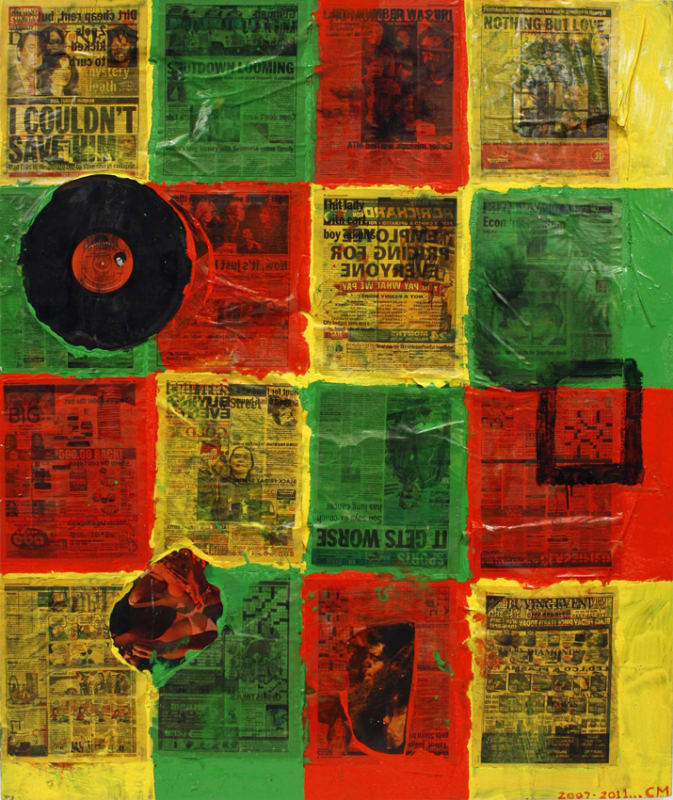Pippy Houldsworth Gallery is delighted to present Mediated Iconography, an exhibition that explores the complex relationship and influence of Richard Hamilton’s work on the practice of a number of important contemporary artists. Including work by The Bruce High Quality Foundation, Richard Hamilton, Marcus Harvey, Anton Henning, Robert Longo, Chris Martin and Mark Wright, the exhibition creates a contemporary counterpoint to and associations with Hamilton's diverse investigations.
Mediated Iconography takes as its starting point the pictorial and psychological depth of Hamilton's work, wherein he mediates and creates a conversation with found imagery through exploration of traditional tropes in painting including the figure, still life, history and landscape. Hamilton’s broad-ranging oeuvre invites us to renegotiate the history and the cultural significance of images and objects. From his deep research into Duchamp’s body of work, to his scientific investigations and observations around consumer culture in the seminal exhibitions, Growth and Form, 1951, and Man, Machine & Motion, 1956, both held at the ICA, and This is Tomorrow, shown at the Whitechapel in 1956, Hamilton was deeply interested in the complex of modern life. His piece Picasso’s Meninas, 1973, exhibited here, is a layered iconographic tableau where Picasso’s styles and characters inhabit Velazquez’s courtroom painting. Visualising himself as author of the reinvented spectacle, depicted in the mirror with his wife in place of the Spanish royals, looking back and through histories of painting, Hamilton evokes an ever-present modern desire and consciousness of the image.
Rich with visual and art historical mnemonics, Hamilton’s tabular paintings embrace the possibilities of semi-illusionistic space, where he plays simultaneously with the vertical picture’s association with the magazine format or computer screen as much as the possibilities of the painted canvas. His work speaks of the assimilation of mass-cultural forms into a fine art tradition, and this transformative moment, where one is invited to visualise the world through the gaze of various forms of modernism, is the psychological and hermeneutic framework that concerns each of the selected contemporary artists, after Hamilton.
The Bruce High Quality Foundation’s acrylic and silkscreen painting, The Princess, 2012 isolates the image of Infanta Margarita from Velazquez’s continuous illusionistic space, inviting us to look at the point at which a painting becomes an image, and how in turn an artwork is consumed. As in Marcus Harvey’s The Attendant (Black and White), 2010, and Robert Longo’s Study of Kiss Guitarist (Ace), 2012, BHQF’s piece explores the category of the figure. Like Hamilton, each artist reflects on the gesture of producing an image within this and other traditional genres, exploring values within them. Harvey’s work investigates, through the materiality of painting, its relationship to the photographic, to the digital image and to painting’s own history. Also photographically based, Longo’s work explores the power of the image in contemporary society, using drawing to evoke a complex psychological state and a socially charged moment. Longo explores what Hamilton called ‘ironies of affirmation’ – where value and taste become the subject matter of Longo’s drawing of Ace the guitarist, or Hamilton’s homage to the Braun toaster.
Mark Wright translates a 1950s landscape postcard through the lens of nineteenth century romanticism, with a nod to modern romanticism in Ed Ruscha and Hamilton himself. Hamilton’s characteristic abstract use of newspaper and magazine layouts take on a musical and ‘gimmicky’ character, also firmly indebted to his pseudo-manifesto about Pop Art, in Chris Martin’s piece Nothing But Love.., 2007-2011. Anton Henning works within the framework of the interior, where his painterly composition, Interieur No. 83, 2001, slips into and out of abstract space. The simultaneously familiar and otherworldly space in Henning’s painting, together with his unironic exploration of Van Gogh, through Lichtenstein, again, draws us back to Hamilton. Each of the works brought together for Mediated Iconography explore and conceptualise the tableau tradition, after Hamilton, where information and image are combined to communicate ideas about and through popular visual culture.
